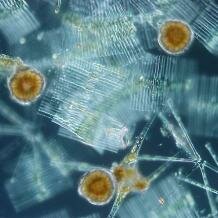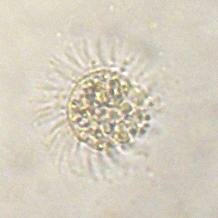Topic: Chloroplast and mitochondrial plastid origins
Not only are there intriguing parallels in the story of gene loss in chloroplasts and mitochondria, but there is also the re-invention of bacterial pathways, such as oxidation of quinols.
Endosymbiotic origins
Many aspects of the origin of the eukaryotic cell are still very controversial, but it is universally agreed that the chloroplasts and mitochondria are the result of primary endosymbiosis, being derived respectively from the cyanobacteria and a group of aerobic bacteria (the α-proteobacteria), most similar to the extant pathogen Ricksettia that is responsible for typhus. It has also been very widely agreed that these were single events, but recently this has been questioned, notably for the chloroplasts.
Gene export
In both chloroplasts and mitochondria there has been dramatic reduction in the size of the genome, with many genes being exported to the host nucleus (or even been totally lost).  There has been a great deal of discussion as to why this happened, but the most likely explanation is that although of very different origins chloroplasts and mitochondria have the same function, and that is to transduce energy. In the chloroplasts this is, of course, to harness in-coming sunlight, whilst in the mitochondria the transduction involves the burning of sugars by aerobic respiration. Both, therefore, have electron transport chains, the genes for which need to be in close proximity to the processes of photosynthesis and respiration. These are, of course, highly energetic processes and lead to the production of free radicals such as super-oxides that are powerful mutational agents. It is sensible, therefore, to export all but the essential genetic machinery to the relative safety of the nucleus. Incidentally, as Stefan Berry has stressed, not only are there intriguing parallels in the story of gene loss in chloroplasts and mitochondria, but there is also the re-invention of bacterial pathways, such as oxidation of quinols. The crucial point is that if the adaptive demands of gene export are the same then the evolutionary pathway will be very much the same however many times cyanobacteria were captured to become chloroplasts in the early evolution of the eukaryotes. This is the argument put forward by John Stiller, and although it has met with some scepticism, it is clear that an open mind needs to be kept concerning the likely convergent evolution of at least the chloroplasts.
There has been a great deal of discussion as to why this happened, but the most likely explanation is that although of very different origins chloroplasts and mitochondria have the same function, and that is to transduce energy. In the chloroplasts this is, of course, to harness in-coming sunlight, whilst in the mitochondria the transduction involves the burning of sugars by aerobic respiration. Both, therefore, have electron transport chains, the genes for which need to be in close proximity to the processes of photosynthesis and respiration. These are, of course, highly energetic processes and lead to the production of free radicals such as super-oxides that are powerful mutational agents. It is sensible, therefore, to export all but the essential genetic machinery to the relative safety of the nucleus. Incidentally, as Stefan Berry has stressed, not only are there intriguing parallels in the story of gene loss in chloroplasts and mitochondria, but there is also the re-invention of bacterial pathways, such as oxidation of quinols. The crucial point is that if the adaptive demands of gene export are the same then the evolutionary pathway will be very much the same however many times cyanobacteria were captured to become chloroplasts in the early evolution of the eukaryotes. This is the argument put forward by John Stiller, and although it has met with some scepticism, it is clear that an open mind needs to be kept concerning the likely convergent evolution of at least the chloroplasts.
Points fuelling debate about cyanobacterial origins
a) As Anthony Larkum and colleagues stress, it is premature to dismiss a polyphyletic origin of chloroplasts. First, the sampling we have is seriously incomplete. Second, and partly linked to this is that whilst chloroplasts are clearly of cyanobacterial origin they are not closely related to any extant species. It is, therefore, perfectly conceivable that a primary endosymbiosis of cyanobacteria occurred more than once, drawing on one or more groups within the cyanobacteria. Third, existing phylogenetic trees are still quite speculative and suffer various problems of analysis.
 b) In the analogous case of a symbiotic relationship between a sea-slug, Elysia chlorotica (a gastropod mollusc) and green algae, where the sea-slug sequesters the cyanobacteria there has clearly been horizontal gene transfer from the chloroplasts (ultimately, of course, of cyanobacterial origin) and the mollusc.
b) In the analogous case of a symbiotic relationship between a sea-slug, Elysia chlorotica (a gastropod mollusc) and green algae, where the sea-slug sequesters the cyanobacteria there has clearly been horizontal gene transfer from the chloroplasts (ultimately, of course, of cyanobacterial origin) and the mollusc.
c) Evidence of primary endosymbiosis in the making today suggests that there could have been multiple endosymbiosis events in the past. The best-known example is an amoeba Paulinella chromatophora. Paulinella has long been known to house a symbiotic alga, and this is now established not only to be a cyanobacterium but one that is not closely related to any chloroplast. The association appears to be obligate, and in particular symbiont and amoeba have synchronized cell division. It is also likely that some genes have been transferred from the cyanobacterium to the nucleus of the host (how else to explain cell division synchronization), but there has not been wholesale transfer of the cyanobacterial genome. A second case involves a freshwater diatom (Rhopalodia gibba) that again has an obligate association with a cyanobacterium.  At first sight this is a bit odd because the diatom is photosynthetic, so it hardly needs a photosynthesizing guest. In point of fact the cyanobacteria is involved with nitrogen reduction (as cyanobacteria do in the free-living colonies using specialized cells called heterocysts), and these provide essential nutrients to the diatom. The process of nitrogen fixation takes place in the dark.
At first sight this is a bit odd because the diatom is photosynthetic, so it hardly needs a photosynthesizing guest. In point of fact the cyanobacteria is involved with nitrogen reduction (as cyanobacteria do in the free-living colonies using specialized cells called heterocysts), and these provide essential nutrients to the diatom. The process of nitrogen fixation takes place in the dark.
d) Two complex endosymbioses in single-celled protistans are particularly interesting. In the ciliate Myrionecta rubra there are symbiotic plastids (from a group of protistans known as the cryptophytes), but the ciliate also needs to “steal” nuclei from the cryptophyte in order for the chloroplasts to continue to function. One nucleus can serve up to eight plastids, and function for up to a month until it needs to be replaced. This sophisticated genomic interaction indicates that complex endosymbiotic arrangements are possible to evolve. The second example is a flagellate (Hatena arenicola) that has an extraordinary symbiosis with a protistan belonging to the group known as the prasinophyceans.  The symbiont is largely reduced to a plastid, so evidently the flagellate benefits from the photosynthetic products of the symbiont. Extraordinarily, however, the symbiont retains its eye-spot and this is evidently used by the flagellate for navigation, as it crawls across sand-grains. This symbiosis, however, is not obligate because when Hatena undergoes cell division the symbiont cleaves to one cell, leaving the other bereft. What happens? The “lucky” daughter cell is self-sufficient with the photosynthetic symbiont, but the other then transforms itself into a heterotroph and starts to feed.
The symbiont is largely reduced to a plastid, so evidently the flagellate benefits from the photosynthetic products of the symbiont. Extraordinarily, however, the symbiont retains its eye-spot and this is evidently used by the flagellate for navigation, as it crawls across sand-grains. This symbiosis, however, is not obligate because when Hatena undergoes cell division the symbiont cleaves to one cell, leaving the other bereft. What happens? The “lucky” daughter cell is self-sufficient with the photosynthetic symbiont, but the other then transforms itself into a heterotroph and starts to feed.
e) In addition to the symbiotic associations desribed above it is also clear that secondary (or even tertiary!) endosymbiosis has occurred whereby one eukaryotic cell (or part thereof) enters into symbiotic association with another eukaryote. There has been discussion as to how many times such secondary endosymbioses may have occurred, but a minimum estimate is twice. Interestingly there are also other convergences, notably in comparison between two endosymbioses involving a cryptomonad and a chloroarachniophyte and in both cases not only has there been a startling reduction in genome size but also in a highly convergent fashion.
Finally, in the wider context of evolutionary convergence it is worth noting that dramatic decreases in genome size are also seen in other types of endosymbiont, notably in the α-proteobacteria that are associated with sap-feeding insects, and also pathogenic bacteria. In these cases there are also parallelisms within the specific groups.
Cite this web page
Map of Life - "Chloroplast and mitochondrial plastid origins"
https://mapoflife.org/topics/topic_158_chloroplast-and-mitochondrial-plastid-origins/
March 4, 2021

